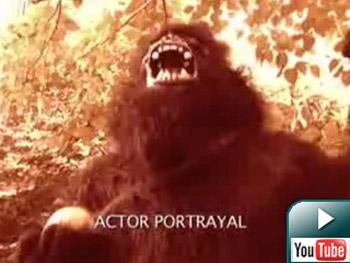
Video by Drew Mintz, Dale Fitzgerald and Robert Slawinski
While working on a class project about disgraced journalists, Cuda and Blair began digging into the file of Jay Forman, a freelance writer who wrote a story for the online magazine, Slate, titled Monkeyfishing: Cruel and Unusual? or Good Sporting Fun?
The story, which was published in June 2001, chronicled the adventures of an intrepid but conflicted journalist who claimed to have fished for rhesus monkeys – abandoned by a pharmaceutical firm – on an island in the Florida Keys. Forman claimed to have taken up this task on a small boat with a pole baited with apples and citrus.
Soon after the story was published, Slate was bombarded with emails questioning the story’s veracity. The Wall Street Journal’s online opinion column, Opinionjournal.com, challenged not only the accuracy of the article but the judgment of its editor Michael Kinsley. “[Kinsley] is a very clever fellow, but he’s always struck us as somewhat unworldly,” wrote OpinionJournal.com.“You know what we mean–the sort of guy who has a lot of book learning but is short on street smarts. Well, it appears he has fallen for an obvious hoax.”
In spite of mounting evidence of total fabrication, Slate stood behind the basic elements of the monkeyfishing yarn. On June 25, 2001, Kinsley offered a tortuous defense of the article. “Despite suggestions by others that the entire episode was fiction, this excursion did take place,” Kinsley wrote. “Contrary to allegations that no such practice ever existed, Kuczynski [a New York Times reporter who tracked down the fisherman who supposedly took Forman fishing] also confirms that monkeyfishing occurred on other occasions before the one Forman describes.”
Kinsley closed with this assertion: “[Slate] stands by our writer and his stories . . . Nothing is ever the final word, but after several days of accusations, there is no evidence that he made this stuff up and lots of evidence that he didn’t.”
And so it stood for almost six years, until last February when The New York Times ran an article featuring the work of Gretchen Cuda and Leonardo Blair. Cuda told StinkyJournalism how they had managed to blow the story out of the water with a single call to Jay Forman. After speaking with the students, Forman called editor Jack Shafer and made a full admission that the story had been fabricated. Shafer, in turn, offered a succinct apology: “In a note to me, Forman apologized for betraying Slate’s trust and for taking so long to come clean,” wrote Shafer. “I, in turn, apologize to Slate’s readers for publishing the story.”
While press swirled about Forman’s admission and Slate’s response, not one story we saw gave details about Blair and Cuda’s sleuthing. In April, Cuda sat down with Stinky Journalism to speak about her group’s work.
| APRIL 2007 INTERVIEW between ASRL editor Jeremy Miller and journalist Gretchen CudaJEREMY MILLER: Can you tell us a bit about your background and how you became interested in investigative journalism?GRETCHEN CUDA: I come from a science background. Some people thought it was initially unusual, that I would move from science to journalism. Scientists are the investigative journalists of the natural world. So I think the two are actually quite naturally linked. And when I left science and went into journalism, I found, after a little bit of time, that there were certain stories that I sort of didn’t know how to proceed on.MILLER: What are some of the greatest challenges you have faced as a young journalist? What do you do to make sure you’re getting the story “right”?CUDA: I can see sometimes how people change their reaction when they’re talking to a reporter. You have to spend more time with people and get them to sort of forget who you are and what you’re doing, so that it’s not a performance for you. I think a lot of times, as reporters, we tend to believe what it is that people tell us. People might have a certain agenda of how they want you to spin the story. They’ll try very hard to make you see the story and write the story in the way that benefits them. That’s something that, as a journalist, you always have to struggle against.The other thing that you can do is ask for documents. I had a situation recently where I did an on camera interview, and the person told me something that turned out not to be true, because she misremembered it. And it was only because I asked for a document to back that up that we found out that that really wasn’t how it happened.Even when they’re not trying to deceive you, they remember things wrong. They make errors in their statements. So you say that “at this meeting such and such was said? Are there minutes to that meeting? Do you have a copy of the letter that you wrote to so and so, or a court document?” You check and double check.
MILLER: How do you make sure, after you’ve done your reporting, that all your facts are straight? CUDA: Whenever I do a story, I go back through it. Unless it’s just a totally novel story that no one’s done before, then obviously I’ve read stories that other people have written. I look at what they wrote and I look at what I wrote, and I make sure that my writing is my writing, and that it’s not something that I have drawn too much from somebody else. I fact check everything. Once I write the story, or I at least have a draft, I go back to the source and say you said this? Especially in science. I go back and say you said that the dose was 100 milligrams per kilogram; is that correct? You want to get it right. That’s the ultimate goal. MILLER: Who is Jay Forman and how did you get onto the “monkeyfishing” case? CUDA: In 2001, Jay Forman had written this outrageous story about how he’s gone to the Florida Keys and fished for monkeys. It was published in Slate. And almost immediately, people didn’t believe it. The Wall Street Journal, opinion journal, called it out. And then the New York Times called it out. And there was a lot of media flurry and blog flurry about it. Slate initially stood behind him and said he says everything is true. They called up some of his sources and checked, and still said it was true. And then little by little, he admitted that some details were false. Or he maybe had remembered them incorrectly. I don’t know exactly which details he ended up conceding on, but he basically said that the premise of the story was true. He did go there on this fishing trip, and he did fish for monkeys, but that maybe he embellished a little. When we went to investigate the story, I really didn’t think it was going to be anything spectacular. I really just expected to call him up and find out a little bit more about him. We called him up and Leo actually spoke to him initially and told him what we were doing. And I had sent him an email. He ended up calling up his former editor, Jack Shafer, and confessing that the whole thing was completely made up, that he really didn’t go there, that it was a story that he heard from a friend and just pretended was true. Ultimately I don’t think he would have called Jack Shafer and admitted this if we hadn’t first called him I don’t think we actually said anything that for any reason would have made him want to confess. We just wanted to find out what was going on. Jack Shafer sent me an email and Jay Forman had written us a note, saying what he had told Jack Shafer more or less was that I’m very sorry about what happened, I’m not a serial fabricator but I did make this up and I really regret it. A few days later, Jack wrote an editorial about this on Slate. MILLER: Was it difficult for you, as a journalist, to turn the investigative lens back onto the media – in particular, onto a journalist who’d made such a dumb error? CUDA: I generally don’t feel squeamish about exposing people who are doing something wrong. Initially I sort of sympathized with this person who perhaps had been very naïve. I didn’t know a lot about him maybe he wasn’t very experienced. I mean, everybody does really stupid things. I don’t really tend to think of people as just being out and out liars and making things up. But my sense is he really absolutely, blatantly took the story that he knew was completely untrue and purposefully said that it happened when he knew that it didn’t. It’s as simple as that. MILLER: Is this case emblematic of a bigger, systemic problem in the media? CUDA: I don’t really think that it’s a systemic problem. Perhaps that’s optimistic or naïve but I think that for the most part, journalists as a whole are very honest and they want to tell good stories and they want to tell stories that are the truth and impact people. I don’t think that people are just out there making stuff up. there are safeguards in place and I think that the safeguards are fact checking, and a good editor who’s paying attention to the writer and can trust them. Out of conversations that I had with Jack Shafer his position is if somebody really wants to lie, if they want to make something up, they’re going to do it. And there is nothing you can do. Fact checking is not designed to catch liars; it’s designed to check, to find mistakes, errors in fact. Another one of [Shafer’s] points that he made to me was in some sense, a lot of what you do as a journalist is just already an implicit trust. Like when you report something that you said, the color of your sweater, or the way this place looks, if I were to write about the Art Science Research Institute, people are going to trust that I’m telling details that I saw and things that I saw happen that are accurate. A few anomalies and you have to pay attention to those people. Journalism is about accuracy and it’s about truth. Fabrication is absolutely not tolerated. It’s not part of what we do. MILLER: But how can you separate the writer from the publication? In other words, if the identity of magazine rides on its content, then, in a sense, a magazine is inseparable from its writers. So how can you say it’s about the writers without implicating the publication? CUDA: The writers are the heart and soul of the magazine or the publication. Just because you have one corrupt politician, does that mean all government is corrupt and you should just throw it out and say forget about it? Or an accountant who’s continually like committing fraud, does that mean that the whole association is bad? It certainly hurts their credibility to have something like this happen at that publication, to have someone at Slate who makes up a story, probably has made up all three of his stories, at least in part – that’s obviously really bad. They handled it the best they could, which was to come out and say –We found that this story is not true and that other stories may also contain inaccuracies or untruths. MILLER: What part do readers have to play in maintaining standards of journalism? CUDA: I think that the reader can actually be a great vetting tool. You’d rather have this happen beforehand. But certainly if someone publishes something that’s false, it’s better to know the truth at some point, later if that’s the case, than not at all. And so I think that readers are incredibly valuable. |






